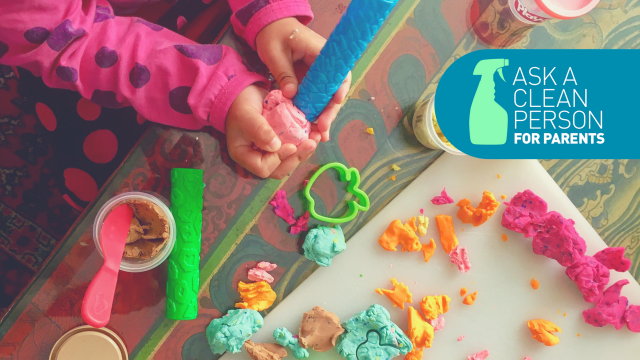Jolie Kerr is a cleaning expert, advice columnist and author of the New York Times bestselling book, My Boyfriend Barfed In My Handbag … And Other Things You Can’t Ask Martha. Her flagship column, “Ask a Clean Person”, debuted in 2011. Here on Lifehacker, we’ve launched a new iteration of it, focusing on parenting and all the messes it brings.
Play-Doh was left in a pants pocket then put through the wash — now there’s an oily looking stain on the outside of the pants (also in the pocket, but I don’t care about that). OxiClean didn’t work, Spray ‘N Wash, Tide Pen also did not.
I know you know that checking pockets is a thing you should be doing, and so I’m not going to go into a whole song and dance about it — but I have to mention it because otherwise someone will be like, “YOU DIDN’T MENTION CHECKING THE POCKETS WHAT KIND OF EXPERT ARE YOU?”
The thing is that I’m the kind of expert who lives here in the real world with the rest of you and I know sometimes we don’t always check our pockets before tossing stuff into the wash. It’ll happen!
And when it inevitably does, here are the products and techniques you’ll want to know about for handling things when Play Doh, Chapstick, or other substances containing oils go through the wash.
Household cleaners: While people mainly think of household cleaners such as Pine Sol and it’s more esoteric doppelganger, Lestoil, as products used for cleaning floors, they’re excellent at stain treatment, especially when it comes to grease and oil stains. For Australians, Pine O Cleen should do the same job.
One caveat about using these products in the laundry is that the smell tends to linger if you have an HE washer, so you may want to opt for an alternative grease stain removal product if you have one of those machines.
To use these products, dab a small amount of the product directly on the stain and launder the garment as usual.
Cornflour: Cornflour, as well as talcum and arrowroot, can be used to pull grease stains out of fabric and is a great choice for items that can’t go into the wash, or for treating older and more stubborn grease stains.
What you’ll do is lay the garment flat and put an anthill-style mound of cornstarch on the stain. Allow it to sit, undisturbed, for at least an hour and up to overnight, then brush the cornflour away or dump it in the bin. Any cornflour residue can be wiped off the fabric using an only-barely damp cloth.
The Long Soak: Soaking a badly-stained garment in detergent and oxygen bleach (which is colour-safe and can be used on whites as well as colours and darks) can salvage clothes that have gone through the dryer and come out with lingering stains.
While this option is better for treating lingering food stains and general dinginess, it can also be used in the case of set-in grease stains.
Laundry soap: Fels Naptha is what’s known as a “laundry bar” — it’s basically just a bar of soap that’s used to treat stains on clothes. It’s pretty heavy duty stuff, and so it’s a great thing to tuck into your arsenal of stain removers (plus it’s cheap and doesn’t take up much space!)
Unfortunately it may be tricky to find in Australia, but Sunlight soap appears to be very similar.
To use it, you’ll wet the bar and rub it directly on the stained portion of the garment, which can then be laundered as usual.
It can also help, especially with set-in and particularly tricky stains such as oil and grease, to use a laundry brush (a nail brush or old toothbrush can serve as a laundry brush) to work the product into the stain prior to laundering.
K2r: I saved the best for last! There’s a product called K2r that I’ve recommended ever since a reader told me that she used it to successfully remove a bike grease stain from a fabric Coach handbag.
Well, I recently heard from another reader that she had been using K2r to treat oil and grease stains that have been set-in by dint of having gone through the dryer. Here’s what she shared:
During what I call the Chapstick Incident of 2015, I tried many options for removing the Chapstick from all of the various items that now had multiple grease stains. The only thing that worked for me was K2r. It was a real sanity-saver, and I continue to use it on stains that appear on items that have been through the dryer.
This is how I use it: Pull item out of dryer. See grease stain. Cry. Remember I have K2r and place item in the “to-K2r pile” (my bf is a hobby machinist who uses a lot of Chapstick and I love to cook, so hence the need for the pile). Treat the stain as directed in a well ventilated area by spraying and then allowing to dry. Brush off the hardened powder with a laundry brush because the one included with the can is very stiff and can damage fabric. Spray with Shout (it makes me feel better!) and wash as usual. Air dry.
I heard in your Fresh Air interview that you mentioned K2r in the context of upholstery cleaning, but I wanted to let you know how effective its been for me on set-in grease stains on clothing. Hopefully this will be helpful!

Comments